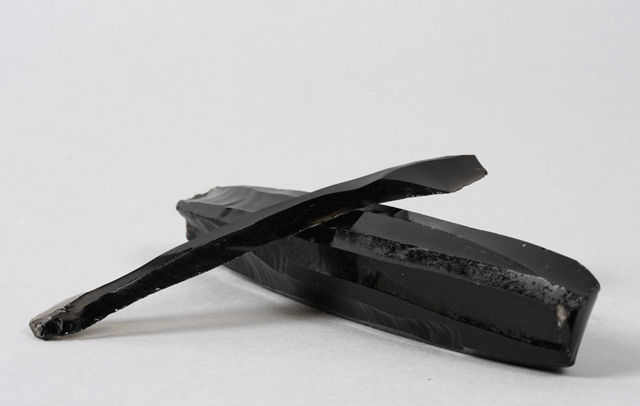

36.4.6, exhausted core; 36.4.7, prismatic blade; both obsidian
Mesoamerica (pre-A.D. 1550)
Transfer from Museum of New Mexico
Photograph by B. Bernard
Today we use the term "cutting edge" to indicate the latest and best of
a particular technology. The
"cutting edge" of stone tool making is represented by
obsidian "prismatic
blades"—long, narrow pieces of stone with somewhat prism-
shaped cross-sections.
As a natural glass, obsidian is the finest stone available for
flaking.
Chunks of obsidian were shaped into a cone, and pressure was applied to the edge of the "base" of the cone until a long, thin blade popped off. The core in the picture is an "exhausted core," meaning that all of the blades that could be removed have been removed. As you can see, by the end of the process the core has lost its cone shape.
The photograph provided above gives a good sense of the thinnness of blades compared to the cores from which they were struck. The next photograph provides a sense of their overall shapes. The blade to the left is the same one as in the previous photograph. The core (to the right) is 13 centimeters (5 inches) long.

(L-R)36.4.7, blade; 36.14.128, bladelet; 36.14.98, core; all
obsidian
Mesoamerica (pre-A.D. 1550)
36.4.7: transfer from Museum of New Mexico;
36.14.98, 36.14.128: Ferdon-Hollenbach-Hibben collection
Photograph by B. Bernard
The smallest blades were called "bladelets."
The bladelet shown here, in the middle, is 7 centimeters
(2 3/4 inches) long.
The result of prismatic blade production is a blade that maximizes the amount of cutting edge obtained relative to the amount of stone used. The blades can be used hand-held, or can be mounted into a handle. When the Spanish arrived in Mexico, they faced Aztec warriors with macanas, wood swords edged with obsidian blades. These weapons could take off a man's arm in a single blow.
Freshly made obsidian blades are sharper than steel ones, but are more brittle and dull more quickly. If not for these limitations, we might still be using obsidian blades today.
To return to the thumbnail, please click here.
All content copyright © Maxwell Museum of Anthropology, University of New Mexico. A high-resolution verson of this photograph may be ordered from the Maxwell Museum's photo archives. Please make note of the catalogue number. For more information please visit the photo archives web page
Page last revised on May 27, 2008. Please report problems to toh@unm.edu